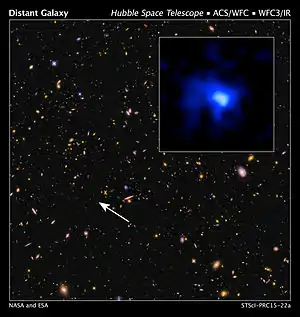Cosmic Assembly Near-infrared Deep Extragalactic Legacy Survey
The Cosmic Assembly Near-infrared Deep Extragalactic Legacy Survey (CANDELS) is the largest project in the history of the Hubble Space Telescope, with 902 assigned orbits (about 60 continuous days[2]) of observing time. It was carried out between 2010 and 2013 with two cameras on board Hubble – WFC3 and ACS – and aims to explore galactic evolution in the early Universe, and the very first seeds of cosmic structure at less than one billion years after the Big Bang.[3]
Science goals
CANDELS is designed to document the first third of galactic evolution – on the redshifts from 8 to 1.5 – via deep imaging of more than 250,000 galaxies. Another goal is to find the first Type Ia supernova beyond z > 1.5 and establish their accuracy as standard candles for cosmology. Additional "daytime" WFC3/UV/Vis exposures in the GOODS-N field were conducted to take advantage of its continuous viewing zone opportunity.[4]
Facility and instruments
CANDELS' main instrument is the Wide Field Camera 3, a near-infrared camera installed on Hubble in May 2009. WFC3 works in tandem with the visible-light Advanced Camera for Surveys, which together gives unprecedented panchromatic coverage of galaxies from optical wavelengths to the near-infrared.[5]
References
- "Astronomers Set a New Galaxy Distance Record". Spacetelescope.org. 6 May 2015. Retrieved 14 June 2015.
- "Hyperwall: CANDELS UDF". nasa.gov. 28 January 2019.
- "Hubble explores the origins of modern galaxies". Spacetelescope.org. 15 August 2013.
- "Science Goals". CANDELS. University of California Observatories.
- "About". CANDELS. University of California Observatories.
